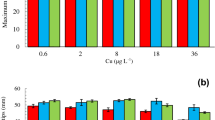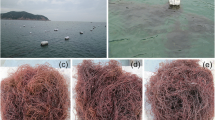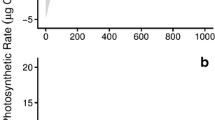Abstract
Phlorotannins, C-based defence compounds in brown seaweeds, show a high degree of spatial and temporal variation within seaweed species. One important model explaining this variation is the Carbon Nutrient Balance Model (CNBM), which states that the relative supply of carbon and limiting nutrients will determine the level of defence compounds in plants. Nitrogen is often considered to be the limiting nutrient for marine macroalgal growth and the CNBM thus predicts that when the carbon:nitrogen ratio is high, photosynthetically fixed carbon will be allocated to production of phlorotannins. In the present study, we evaluated the effects of light (i.e. carbon) and nitrogen on the phlorotannin content of two intertidal brown seaweeds, Ascophyllum nodosum and Fucus vesiculosus. This was done in an observational field study, as well as in a manipulative experiment where plants from habitats with different light regimes were subjected to different nitrogen and light treatments, and their phlorotannin content was measured after 14 days. The results showed that there was a negative relationship between tissue nitrogen and phlorotannin content in natural populations of F. vesiculosus, but not in A. nodosum. In the short term, the phlorotannin content in both algal species was not affected by changes in nitrogen availability. Exposure to sunlight had a positive effect on the phlorotannin content in natural populations of both algal species but, in the manipulative experiment, only F. vesiculosus showed a rapid response to changes in light intensities. Plants subjected to sunlight contained higher phlorotannin content than shaded plants. In conclusion, the results imply that nitrogen availability explains some of the natural variation in the phlorotannin content of F. vesiculosus, but the light environment has greater importance than nitrogen availability in predicting the phlorotannin content of each species.
Similar content being viewed by others
References
Åberg, P., 1992. A demographic study of two populations of the seaweed Ascophyllum nodosum. Ecology 73: 1473–1487.
Arnold, T. M., C. E. Tanner & W. I. Hatch, 1995. Phenotypic variation in polyphenolic content of the tropical brown alga Lobophora variegata as a function of nitrogen availability. Mar. Ecol. Prog. Ser. 123: 177–183.
Berenbaum, M. R., 1995. The chemistry of defence: theory and practice. Proc. natn. Acad. Sci. U.S.A. 92: 2–8.
Berthold, G., 1882. Beiträge zur Morpholgie und Physiologie der Meeresalgen. Jahrb. Wiss. Bot. 13: 569–717.
Bryant, J. P., F. S. III Chapin & D. R. Klein, 1983. Carbon/nutrient balance of boreal plants in relation to vertebrate herbivory. Oikos 40: 357–368.
Bryant, J. P., J. P. Kuropat, S. M. Cooper, K. Frisby & N. Owen-Smith, 1989. Resource availability hypothesis of plant antiherbivore defence tested in South African savanna ecosystem. Nature 340: 227–228.
Carlson, D. J. & M. L. Carlson, 1984. Reassessment of exudation by fucoid macroalgae. Limnol. Oceanogr. 29: 1077–1087.
Carlson, L., 1991. Seasonal variation in growth, reproduction and nitrogen content of Fucus vesiculosus L. in the Öresund, Southern Sweden. Bot. mar. 34: 447–453.
Chapman, A. R. O. & J. S. Craigie, 1977. Seasonal growth in Laminaria longicruris: relations with dissolved inorganic nutrients and internal reserves of nitrogen. Mar. Biol. 40: 197–205.
Crato, E., 1896. Beiträge zur anatomie und physiologie das elementarorganismus. Beitr. Biol. Pflanz. 7: 407–535.
Cronin, G. & M. E. Hay, 1996. Effects of light and nutrient availability on the growth, secondary chemistry and resistance to herbivory of two brown seaweeds. Oikos 77: 93–106.
Fajer, E. D., M. D. Bowers & F. A. Bazzaz, 1992. Effects of nutrients and enriched CO2 environment on production of carbonbased allelochemicals in plantago-a test of the carbon nutrient balance hypothesis. Am. Nat. 140: 707–723.
Hammerstrom, K., M. N. Dethier & D. O. Duggins, 1998. Rapid phlorotannin induction and relaxation in five Washington kelps. Mar. Ecol. Prog. Ser. 165: 293–305.
Hanisak, M. D., 1983. The nitrogen relationships of marine macroalgae. In Carpenter, E. J. & D. G. Capone (eds), Nitrogen in the Marine Environment. Academic Press, New York: 699–730.
Hay, M. & P. D. Steinberg, 1992. The chemical ecology of plantherbivore interactions in marine versus terrestrial communities. In Rosenthal, G. A. & M. R. Berenbaum (eds), Herbivores: Their Interactions with Secondary Plant Metabolites. Academic Press, New York: 371–413.
Herms, D. A. & W. J. Mattson, 1992. The dilemma of plants: to grow or defend. Quart. Rev. Biol. 67: 283–335.
Ilvessalo, H. & J. Tuomi, 1989. Nutrient availability and accumulation of phenolic compounds in the brown alga Fucus vesiculosus. Mar. Biol. 101: 115–119.
Jennings, J. & P. D. Steinberg, 1994. In situ exudation of phlorotannins by the sublittoral kelp Ecklonia radiata. Mar. Biol. 121: 349–354.
Jennings, J. & P. D. Steinberg, 1997. Phlorotannins versus other factors affecting epiphyte abundance on the kelp Ecklonia radiata. Oecologia 109: 461–473.
Karban, R. & I. T. Baldwin, 1997. Induced responses to herbivory. The University of Chicago Press, Chicago: 319 pp.
Karez, C. S. & R. C. Pereira, 1995. Metal contents in polyphenolic fractions extracted from the brown alga Padina gymnospora. Bot. mar. 28: 151–155.
Koricheva, J., S. Larsson, E. Haukioja & M. Keinänen, 1998. Regulation of woody plant secondary metabolism by resource availability: hypothesis testing by means of meta-analysis. Oikos 83: 212–226.
Lau, S. C. K. & P.-Y. Qian, 1997. Phlorotannins and related compounds as larval settlement inhibitors of the tube-building polychaete Hydroides elegans. Mar. Ecol. Prog. Ser. 159: 219–227.
Lazo, L., J. H. Markham & A. R. O. Chapman, 1994. Herbivory and harvesting: effects on sexual recruitment and vegetative modules of Ascophyllum nodosum. Ophelia 40: 95–113.
Lowell, R. B., J. H. Markham & K. Mann, 1991. Herbivore-like damage induces increased strength and toughness in a seaweed. Proc. r. Soc. Lond. B, Biol. Sci. 243: 31–38.
Pavia, H. & E. Brock, 2000. Extrinsic factors influencing phlorotannin production in the brown seaweed Ascophyllum nodosum. Mar. Ecol. Prog. Ser. 193: 285–294.
Pavia, H., G. Toth & P. Åberg, 1999. Trade-offs between phlorotannin production and annual growth in natural populations of the brown seaweed Ascophyllum nodosum. J. Ecol. 87: 761–771.
Pavia, H., G. Cervin, A. Lindgren & P. Åberg, 1997. Effects of UV-B radiation and simulated herbivory on phlorotannins in the brown alga Ascophyllum nodosum. Mar. Ecol. Prog. Ser. 157: 139–146.
Peckol, P., J. M. Krane & J. L. Yates, 1996. Interactive effects of inducible defence and resource availability on phlorotannins in the North Atlantic brown alga Fucus vesiculosus. Mar. Ecol. Prog. Ser. 138: 209–217.
Pedersen, A., 1984. Studies on phenol content and heavy metal uptake in fucoids. Hydrobiologia 116/117: 498–504.
Ragan, M. A. & K.-W. Glombitza, 1986. Phlorotannins, brown algal polyphenols. Prog. Phycol. Res. 4: 129–241.
Reichardt, P. B., F. S. III Chapin, J. P. Bryant, B. R. Mattes & T. P. Clausen, 1991. Carbon/nutrient balance as a predictor of plant defence in Alaskan balsam poplar: potential importance of metabolic turnover. Oecologia 88: 401–406.
Schoenwaelder, M. E. A. & M. N. Clayton, 1998. Secretion of phenolic substances into the zygote wall and cell plate in embryos of Hormosira and Acrocarpia (Fucales, Phaeophyceae). J. Phycol. 34: 969–980.
Sieburth, J. M., 1969. Studies on algal substances in the sea. III. The production of extracellular organic matter by littoral marine algae. J. exp. mar. Biol. Ecol. 3: 290–309.
Sieburth, J. M. & T. J. Conover, 1965. Sargassum tannin, an antibiotic which retards fouling. Nature 208: 52–53.
Steinberg, P. D., 1992. Geographical variation in the interaction between marine herbivores and brown algal secondary metabolites. In Paul, V. J. (ed.), Ecological Roles of Marine Natural Products. Cornell University, New York: 51–92.
Stengel, D. B. & M. J. Dring, 1997. Morphology and in situ growth rates of Ascophyllum nodosum (Phaeophyta) from different shore levels and responses of plants to vertical transplantation. Eur. J. Phycol. 32: 193–202.
Targett, N. M. & T. M. Arnold, 1998. Predicting the effects of brown algal phlorotannins on marine herbivores in tropical and temperate oceans. J. Phycol. 36: 195–205.
Toth, G. & H. Pavia, 2000. Lack of phlorotannin induction in the brown seaweed Ascophyllum nodosum in response to increasing copper concentrations. Mar. Ecol. Prog. Ser. 192: 119–126.
Tugwell, S. & G. M. Branch, 1989. Differential polyphenolic distribution among tissues in the kelps Ecklonia maxima, Laminaria pallida and Macrocystis augustifolia in relation to plant-defence theory. J. exp. mar. Biol. Ecol. 129: 219–230.
Underwood, A. J., 1997. Experiments in ecology: their logical design and interpretation using analysis of variance. Cambridge University Press, Cambridge: 504 pp.
Van Alstyne, K. L., 1995. Comparison of three methods for quantifying brown algal polyphenolic compounds. J. Chem. Ecol. 21: 45–58.
Van Alstyne, K. L., J. J. III McCarthy, C. L. Hustead & D. O. Duggins, 1999a. Geographic variation in polyphenolic levels of Northeastern Pacific kelps and rockweeds. Mar. Biol. 133: 371–379.
Van Alstyne, K. L., J. J. McCarthy, C. L. Hustead & L. J. Kearns, 1999b. Phlorotannin allocation among tissues of northeastern pacific kelps and rockweeds. J. Phycol. 35: 483–492.
Williams, G. A., 1990. The comparative ecology of the flat periwinkles Littorina obtusata (L.) and L. mariae Sacchi et Rastelli. Field Studies 7: 469–482.
Yates, J. L. & P. Peckol, 1993. Effects of nutrient availability and herbivory on polyphenolics in the seaweed Fucus vesiculosus. Ecology 74: 1757–1766.
Rights and permissions
About this article
Cite this article
Pavia, H., Toth, G.B. Influence of light and nitrogen on the phlorotannin content of the brown seaweeds Ascophyllum nodosum and Fucus vesiculosus. Hydrobiologia 440, 299–305 (2000). https://doi.org/10.1023/A:1004152001370
Issue Date:
DOI: https://doi.org/10.1023/A:1004152001370




